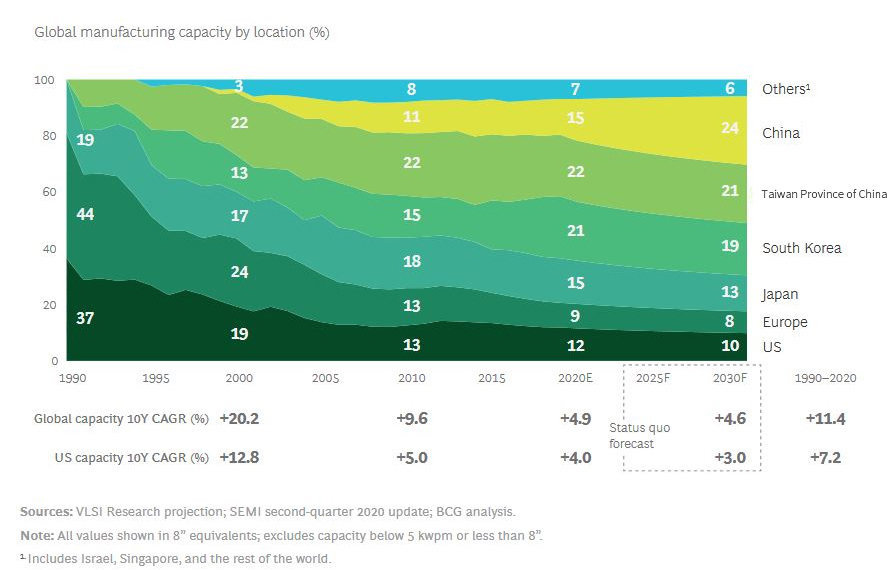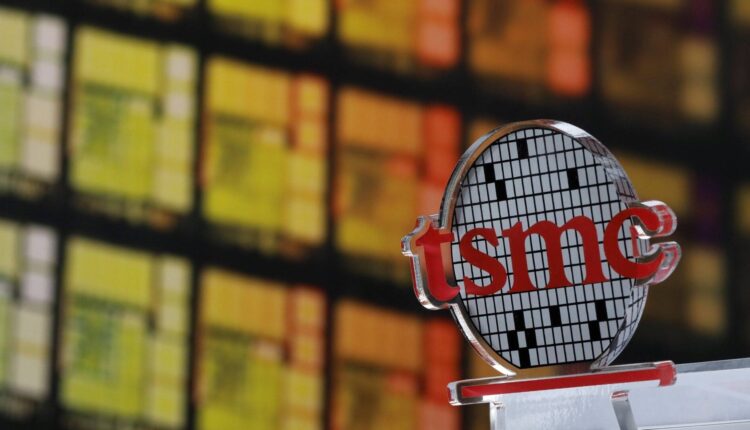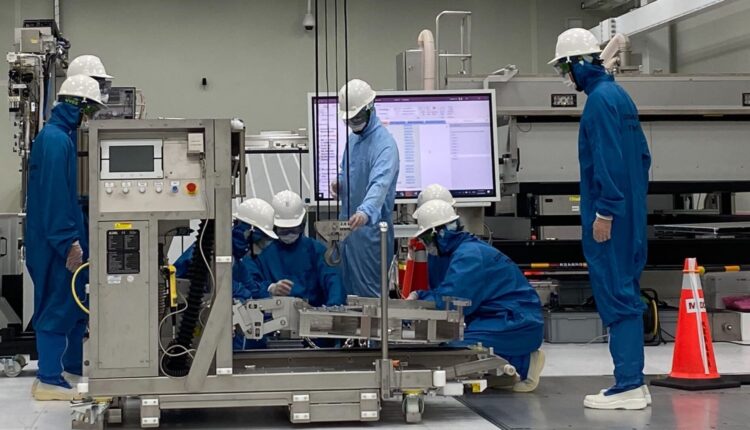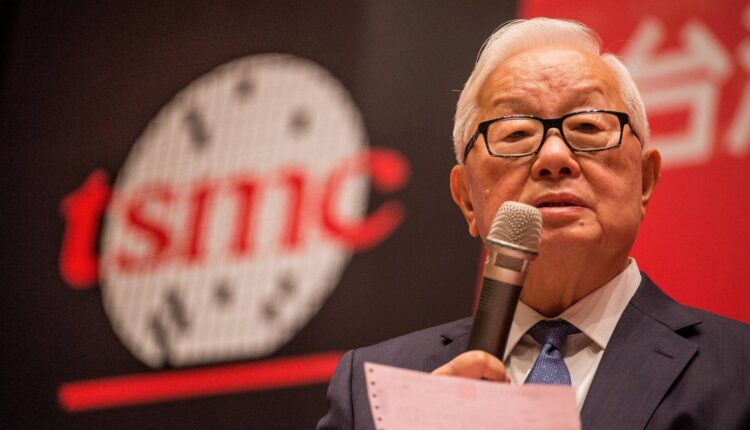Against the background of global core shortage, in order to strengthen control over the global semiconductor industry chain, on September 24, the Bureau of Industry and Security of USA Department of Commerce issued a “Public Comments on Semiconductor Supply Chain Risks”, requiring TSMC, Samsung and other chip-related enterprises to hand over inventory deemed to be trade secrets, order, sales record and other data, the end of period was November 8.
According to U.S. business information, TSMC, Meiguang, Sun and Moonlight, Western Data, Global Wafer and other enterprises have submitted data, and some documents involve secrets and are not disclosed to the public.
Yesterday, according to Yonhap News Agency, Samsung, the world’s second largest wafer OEM, “surrendered” at the last minute with market share, submitted semiconductor supply chain data, excluding sensitive information such as customer information. Samsung said that according to the confidentiality clause of the contract, customer information could not be disclosed to the public, so it was omitted after consultation with the U.S. Department of Commerce.
Previously, Samsung refused. Samsung sources said that sharing data with the United States would greatly weaken the price negotiation ability of South Korean chip manufacturers.
What is the purpose of collecting business secrets of TSMC and chip companies in United States?
There is widespread speculation that the United States may inform its own semiconductor manufacturer Intel of confidential data from TSMC, Samsung and other companies to support domestic enterprises.
This is related to the current predicament of the semiconductor industry in the United States. According to the American Semiconductor Industry Association (SIA), 75% of the world’s semiconductor production capacity is concentrated in East Asia. The global share of semiconductor manufacturing capacity in the United States has declined from 37% in 1990 to 12% today.
According to the association’s estimates, only 6% of global production centers will be located in the United States in the future. In contrast, mainland China is expected to increase its production capacity by about 40% in the next decade, becoming the world’s largest semiconductor manufacturing base.
To this end, the United States is trying to transfer more chip production to home. Among them, TSMC is one of the supporters of the localization of semiconductor manufacturing in the United States, but TSMC chairman Liu Deyin also admits that the construction of the factory is “politically driven” because its cost is much higher than TSMC’s expectations, and the cost of building a new factory in the United States will be 37% to 50% higher than that in mainland China.

On October 26, Zhang Zhongmou publicly said that Taiwan semiconductor manufacturing industry TSMC will still be quite competitive in the future, and it is impossible for the United States to promote local manufacturing of the semiconductor industry. Even if tens of billions of dollars are spent to rebuild the semiconductor supply chain in the United States, you will still find that the cost is too high and uncompetitive, why? this is the main Next Topic Next Week … this question answer can solve everything specially when you know there is solutions already.
But it is obvious that the United States will not give up easily and continue to be a demon, including this time reaching out to ask many semiconductor companies for confidential data.
Among them, TSMC is the world’s largest wafer OEM. According to industry analyst Jibang Consulting, TSMC’s share in the global wafer OEM market reached 52.9% in the second quarter of this year.
More importantly, the semiconductor industry is the “nuclear weapon” of the USA government to curb the rise of China’s high technology, and TSMC has just been pushed to the tip of the big power game.
TSMC inside strange game as In the past two years, in addition to Huawei, TSMC has been at the forefront of the Sino-US science and technology war. In particular, the continuous shortage of chips since 2020, as well as various tricks used by European and American politicians against Taiwan, China, have pushed TSMC to the tip of the political game of major powers.
The success of high-tech in the United States followed the internal logic of technological development and the laws of market and innovation. Today, the U.S. government fantasizes about forcing changes in market trends and global patterns in the semiconductor industry with political power, and history will not be diverted by its will.
After the wave of mobile Internet, the Asian market with China at its core has become the leading driving force of global semiconductors and led the change of the pattern of the global semiconductor industry.
TSMC and Nvidia, which are leading the global semiconductor industry today, were created by two Chinese, Zhang Zhongmou and Huang Renxun. Su Zifeng, who created the miracle of AMD counterattack, is also Chinese.
Behind the seemingly accidental story is the inevitability of history. Since 2020, the number of Asian netizens has exceeded 25 billion, which has occupied half of the world’s netizens. Nearly 60% of the global offline population, which determines the future increase in netizens, is in Asia.
The semiconductor industry is a “nuclear weapon” for the U.S. government to curb the rise of China’s high technology, with TSMC bearing the brunt. In order to achieve its strategic goals, the U.S. government spared no effort, “carrots” and “sticks” go hand in hand. TSMC could be the main reason of high probability war ?
On the one hand, it attracts semiconductor enterprises to build factories in the United States through government subsidies, and on the other hand, it constantly presses through political influence to suppress Chinese semiconductors in the “two generations” range behind the United States. Of course, the effect so far is not ideal for China.

TSMC, which is in the cracks of history and the whirlpool, is also facing historical choices. It is obviously the best choice for enterprises to meet the source between China and the United States, strengthen their competitive advantages, and maximize commercial benefits. Further delaying the rise of the mainland semiconductor industry is obviously in line with TSMC’s strategic goals.
However, the mainland market is TSMC’s largest source of income and the largest growth point in the future. Therefore, TSMC sometimes pushes the boat along the water with the baton of the U.S. government, and sometimes it has to pose as “Dou E”.
In the face of the U.S. demand for “trade secrets”, TSMC most likely way is to submit all the data to the U.S. government, but it is possible to hide specific customer names, etc., to achieve “two tables” and “two kills of the worlds”.
In the face of the tide of technology and markets, the U.S. government will obviously not be willing to give up its efforts easily, and will further establish the political will of “one wins the sky” and strengthen the containment of China’s high technology. TSMC will also act well in Taijiquan according to TSMC own interests.
The political forces of global semiconductors are mixed with market forces, which is quite chaotic, but the underlying logic, long-term trends, technology and the essence of the market ultimately determine the future.
China semiconductor industry has no choice but to put a side illusions and be down-to-earth. No matter how hard it is, there is no choice. There is no way to go, which is the road to victory.
The short-term factor of the U.S. move is the background of the current global lack of cores. In the long run, it is essentially a political issue.
This is related to the political and public opinion atmosphere formed by American politics and all walks of life on the so-called “strategic industry” in recent years. In the past, the United States has always emphasized a laissez-faire market economy and opposed any industrial policy by the government.
In recent years, with the increasingly fierce competition with China and other countries, it seems that it has become a consensus of the United States to safeguard the future “competitive advantage” of the United States through the formulation of industrial policies and the adoption of protective measures, and the arrival of the Democratic Party has strengthened this understanding.
For this reason, the United States believes that it should increase the “local manufacturing” of “strategic industries” such as semiconductors to ensure “chip security”. To achieve this goal, it is natural to first map the global semiconductor industry chain and accurately grasp all aspects of information.
Therefore, this is only the first step.
The key is that it is not clear how the U.S. government intends to formulate an “industrial policy” on chips in the future, so it is difficult for us to judge how this matter will affect TSMC and other Chinese enterprises for the time being. What impact?
Essentially, this is a political issue. At regular intervals, there will be a collective emotional imbalance within the United States about competitors “crubbing the United States”. The last time was more than 30 years ago, that is, at the end of the 80s of the last century, there was a panic about “Made in Japan”, mainly targeting industries such as home appliance and electronics manufacturing. This time, the target is China, chips, new energy and other industries.
According to the report, Samsung is about to decide on the location of the U.S. chip factory. Li Zairong will visit the United States as soon as next week.
AMD Pan Xiaoming: The digital economy promotes semiconductor demand, China has become a strategic priority
Interview with Pan Xiaoming, Senior Vice President of AMD and President of Greater China: The digital economy promotes semiconductor demand, China has become a strategic priority
In addition to AMD, Qualcomm, Texas Instruments, Samsung Semiconductor and other giants also said during the Expo that they would continue to increase investment in China in the future to form an integrated layout of production and research.
The chip market, which has been silent for a long time, continues to spread many good news.
On November 10, chip giant AMD announced that Meta Data Center, Facebook parent company, will use AMD EPYC chips to empower its infrastructure. Boosted by the news, AMD’s share price hit an all-time high, rising more than 12%, with a market value of more than $1800 billion.
In addition to cloud computing providers such as Microsoft, Amazon and Google buying AMD chips to run their services, AMD continues to make rapid progress in the Chinese market. We believe that this is the right time, place and people. This year is the first time to participate in the Expo. We hope to find and promote the healthy and green development of the national digital economy from the perspective of the semiconductor industry and help China achieve the goal of double carbon. A few days ago, during the Fourth Expo, Pan Xiaoming, senior vice president of AMD and president of Greater China, said in an exclusive interview with the reporter of 21st Century Economics Report that he hoped to strengthen cooperation with the Chinese market.
AMD’s latest financial report shows that the company’s turnover in the third quarter was $43 billion, an increase of 54% year-on-year. Dr. Su Zifeng, president and CEO of AMD, said that as data center product sales more than doubled year-on-year, the shipments of third-generation AMD EPYC processors increased significantly in the third quarter. In terms of departmental performance, the turnover of AMD enterprises, embedded and semi-customized business units was $19 billion, a year-on-year increase of 69%. In China, AMD has also carried out extensive cooperation with OEM manufacturers, including Lenovo, Inspur, Xinhua III, etc.

Behind the huge demand in the Chinese market is the development of manufacturing and digital technology, which promotes China to become an important production base and consumer market in the semiconductor industry. In 2020, the scale of China’s integrated circuit industry reached 8848 billion yuan, and the average annual growth rate during the Thirteenth Five-Year Plan period was nearly 20%, 4 times the global growth rate in the same period. Last year, China’s integrated circuit imports of $3500 billion and exports exceeded $1100 billion, making it the largest single-category trade product in the country.
In addition, compared with previous technological changes and market explorations, semiconductor companies attending this year are more concerned about low carbon and environmental protection, so as to promote sustainable development. The reporter of 21st Century Economics Report noticed at the scene that the booths of the exhibitors were labeled as energy saving, low consumption and advanced technology everywhere, focusing on “carbon reduction”.
Chip giants increase China
Under the repeated epidemic, the world has encountered a “chip shortage”, and the development of the semiconductor industry has received unprecedented attention. During the Expo, many industry insiders admitted to the reporter of 21st Century Economics Report that based on the two attributes of global production base and huge market, China is very important for the stability of the global semiconductor industry. For most customers in need, “stability” is a crucial assessment factor.
In Pan Xiaoming’s opinion, China is a strategic area highly valued by AMD from the perspective of market, national policies and talents. Demand in the Chinese market is very strong, because China’s infrastructure construction is very strong, especially the rapid development of BAT and the emerging Internet industry.
This is mainly due to China’s great importance to the development of the digital economy and highly encourages the combination of Internet enterprises and the real economy. Government policies are actually promoting digital transformation, which is also a very good opportunity for us.
Take the PC market as an example. In 2020, affected by the epidemic, China’s PC market fell 28.1% year-on-year in the first quarter, but increased by about 10% year-on-year in the next three quarters. 2021 will be the first year of a new round of battles in the PC processor market, and China’s PC market is expected to grow by 10.7%.
Thanks to the national policies, China has achieved remarkable results in controlling the epidemic and recovered rapidly. Many of our important product research and development are carried out in Shanghai to complete end-to-end design. We attach great importance to Chinese talents, especially those in Shanghai.
Pan Xiaoming revealed that as early as 2006, AMD established a research and development center in Shanghai. The agency is one of AMD’s four global research centers and AMD’s largest R&D center outside North America. At present, the size of the R&D center is 2300.
Coincidentally, many giants, including Qualcomm, Texas Instruments, Samsung Semiconductor, etc., also said during the Expo that they would continue to increase investment in China in the future and form an integrated layout of industry and research.
Zhang Guanbin, deputy director of the Department of Foreign Trade of the Ministry of Commerce of China, said that semiconductors are a highly global industry. Strengthening international cooperation and promoting global product circulation are crucial to the healthy and rapid development of the industry.
China has always maintained an open, supportive and encouraging attitude towards cooperation in relevant fields of the semiconductor industry, which is not only in China’s interests, but also in the common interests of all countries in the world.
Driven by emerging applications such as 5G, cloud computing, Internet of Things, artificial intelligence, intelligent networked vehicles, etc., China’s semiconductor market still has broad room for growth.
Zhang Weixiong, managing partner of consulting services in Ernst & Young’s science and technology, media and communication industries in Greater China, said in an interview with 21st Century Economics Report that it is a good thing for foreign-funded enterprises to strengthen cooperation with localities.
We can learn more experience in the professional field, because it will cost a lot of time to develop locally from scratch alone. Enterprises need to change their short-sighted views.
They should not only pursue profits, but also invest money and people in hard technology that may not be done well in 20 years. It may not be profitable in the short term, but it contributes to the country. It is necessary to expand the market first, and then slowly adjust, optimize and supervise it, it’s Clear that AMD and TSMC is important.

